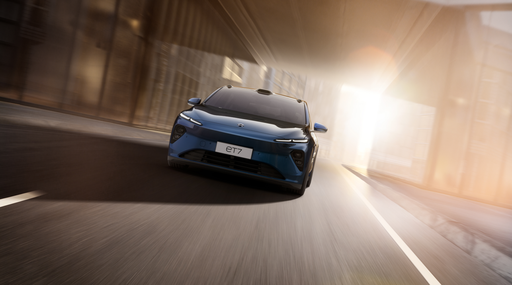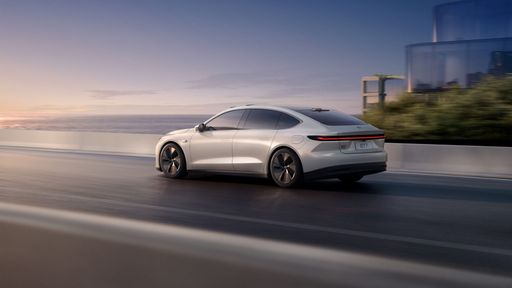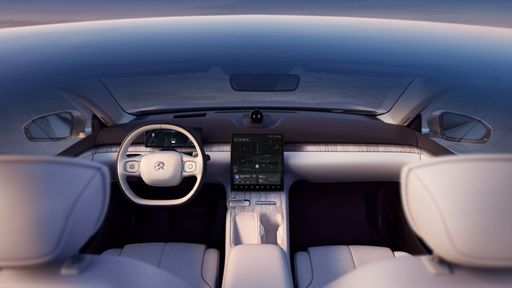Citroen Jumper vs NIO ET7 – Differences & prices compared
Compare performance, boot space, consumption and price in one view.
Find out now: which car is the better choice for you – Citroen Jumper or NIO ET7?
The Citroen Jumper (Cargo Van) comes with a Electric or Diesel engine and Automatic or Manuel transmission. In comparison, the NIO ET7 (Sedan) features a Electric engine with Automatic transmission.
When it comes to boot capacity, the Citroen Jumper offers , while the NIO ET7 provides 363 L – depending on how much space you need. If you’re looking for more power, decide whether the 279 HP of the Citroen Jumper or the 653 HP of the NIO ET7 suits your needs better.
In terms of consumption, the values are 26.20 kWh7.50 L per 100 km for the Citroen Jumper, and 18.50 kWh for the NIO ET7.
Price-wise, the Citroen Jumper starts at 34200 £, while the NIO ET7 is available from 59900 £. Compare all the details and find out which model fits your lifestyle best!
Citroen Jumper
The Citroen Jumper impresses with its robust design and exceptional versatility, making it a popular choice for both business and leisure purposes. Its spacious interior is thoughtfully designed to maximise comfort and practicality, providing ample room for passengers and cargo alike. With a smooth driving experience and a range of advanced safety features, the Jumper is well-equipped to handle the demands of modern motoring.
detailsNIO ET7
The ET7, NIO's premium electric sedan, combines cutting-edge technology with luxurious comfort to create a remarkable driving experience. Its sleek design is not only visually captivating but also enhances aerodynamic efficiency, contributing to its impressive performance. With a focus on sustainability, the ET7 promises to redefine the landscape of electric mobility with its innovative features and environmentally-friendly credentials.
details @ NIO
@ NIO
 @ NIO
@ NIO
 @ NIO
@ NIO

|
|
|
|
|
Costs and Consumption |
|
|---|---|
|
Price
34200 - 57800 £
|
Price
59900 - 68900 £
|
|
Consumption L/100km
7.5 - 9 L
|
Consumption L/100km
-
|
|
Consumption kWh/100km
26.20 kWh
|
Consumption kWh/100km
18.5 - 19.1 kWh
|
|
Electric Range
424 km
|
Electric Range
451 - 584 km
|
|
Battery Capacity
97.80 kWh
|
Battery Capacity
73.5 - 90 kWh
|
|
co2
0 - 233 g/km
|
co2
0 g/km
|
|
Fuel tank capacity
90 L
|
Fuel tank capacity
-
|
Dimensions and Body |
|
|---|---|
|
Body Type
Cargo Van
|
Body Type
Sedan
|
|
Seats
3
|
Seats
5
|
|
Doors
4
|
Doors
4
|
|
Curb weight
2075 - 2940 kg
|
Curb weight
2434 - 2454 kg
|
|
Trunk capacity
-
|
Trunk capacity
363 L
|
|
Length
5413 - 6363 mm
|
Length
5101 mm
|
|
Width
2050 mm
|
Width
1987 mm
|
|
Height
2254 - 2850 mm
|
Height
1509 mm
|
|
Payload
560 - 2020 kg
|
Payload
446 - 466 kg
|
Engine and Performance |
|
|---|---|
|
Engine Type
Electric, Diesel
|
Engine Type
Electric
|
|
Transmission
Automatic, Manuel
|
Transmission
Automatic
|
|
Transmission Detail
Schaltgetriebe, Automatikgetriebe
|
Transmission Detail
-
|
|
Drive Type
Front-Wheel Drive
|
Drive Type
All-Wheel Drive
|
|
Power HP
120 - 279 HP
|
Power HP
653 HP
|
|
Acceleration 0-100km/h
-
|
Acceleration 0-100km/h
3.80 s
|
|
Max Speed
90 - 170 km/h
|
Max Speed
200 km/h
|
|
Torque
320 - 450 Nm
|
Torque
850 Nm
|
|
Number of Cylinders
4
|
Number of Cylinders
-
|
|
Power kW
88 - 205 kW
|
Power kW
480 kW
|
|
Engine capacity
2184 cm3
|
Engine capacity
-
|
General |
|
|---|---|
|
Model Year
2024
|
Model Year
2022
|
|
CO2 Efficiency Class
A, G
|
CO2 Efficiency Class
A
|
|
Brand
Citroen
|
Brand
NIO
|
Citroen Jumper
A Game-Changer in the Electric Van Market: The Citroën Jumper
The Citroën Jumper stands out in the realm of electric vans, bringing a blend of innovation, efficiency, and versatility to the table. This vehicle is designed to meet the needs of businesses searching for sustainable transport solutions, while also delivering impressive performance and technology.
Power Meets Performance: Technical Specifications
The Citroën Jumper is powered by an electric motor that provides an impressive 270 PS (200 kW) output. It operates with front-wheel drive and utilises an automatic transmission for smooth and efficient power delivery. The vehicle boasts a maximum torque of 410 Nm, ensuring it can handle various loads with ease.
A critical factor for business owners is operational cost, and the Jumper excels with a consumption rate of 26.2 kWh/100km and a driving range of 424 km on a full charge. This efficiency is complemented by a zero-emissions output, earning it a CO2 efficiency class of A.
Innovative Design and Features
Citroën has ingeniously optimised the Jumper's design for practicality and comfort. With a body style classified as a transporter, the vehicle is crafted for utility without sacrificing on essentials. It features a standard four-door configuration and offers seating for three, making it a practical choice for various industries.
The versatility in design is reflected in its various configurations, capable of accommodating different load requirements with a payload capacity ranging from 560 to 1385 kg. The Jumper's dimensions vary slightly with model choice, with lengths between 5998 mm and 6363 mm, width at 2050 mm, and height ranging from 2612 mm to 2850 mm.
Electric Innovation at its Core
At the core of the Citroën Jumper is its robust 97.8 kWh battery, making long journeys more feasible in the realm of electric vehicles. Notably, the vehicle maintains a lighter carbon footprint, contributing to sustainable transport solutions with its zero CO2 emissions.
Another innovation is the vehicle's capacity to reach top speeds between 90 km/h to 130 km/h, which shows that electric vans can maintain competitive performance metrics.
A Worthy Investment
While the Citroën Jumper signifies a higher initial investment, with prices ranging from €65,212 to €68,425, it promises considerable savings in fuel costs and environmental benefits over time. It presents an attractive proposition for businesses keen on contributing positively to the planet while maintaining operational efficiency.
In summary, the Citroën Jumper is a perfect embodiment of how electric vehicle technology can adapt to commercial needs, offering an efficient, innovative, and environmentally friendly transport solution.
NIO ET7
Introduction to the All-New NIO ET7
The NIO ET7, a flagship sedan from the innovative Chinese automaker NIO, has made significant waves in the electric vehicle (EV) market. With its sleek design, cutting-edge technology, and impressive performance, the ET7 aims to redefine luxury and efficiency in the EV landscape. Available in both Long Range and Standard Range configurations, the ET7 promises a captivating driving experience tailored for discerning enthusiasts and eco-conscious drivers alike.
Performance and Technical Specifications
At the heart of the NIO ET7 is a powerful electric motor that delivers an exhilarating performance with 653 horsepower (HP) and 850 Nm of torque. This dynamic powerhouse enables the ET7 to accelerate from 0 to 100 km/h in just 3.8 seconds, making it not only fast but also smooth and responsive thanks to its Automatic Reduction Gearbox.
The ET7 features an all-wheel-drive system, ensuring steady and secure handling across various driving conditions. Whether you're navigating urban streets or cruising on the highway, the ET7's maximum speed of 200 km/h offers an optimized balance between speed and stability.
Range and Energy Efficiency
Efficiency is a cornerstone of the ET7's design. The Long Range version boasts an impressive electric range of 584 km, with a battery consumption of 18.5 kWh per 100 km. Meanwhile, the Standard Range offers a respectable 451 km with a slightly higher consumption of 19.1 kWh per 100 km. These ranges are supported by battery capacities of 90 kWh for the Long Range and 73.5 kWh for the Standard Range versions.
Furthermore, the ET7's CO2 Efficiency Class A designation highlights its environmentally friendly credentials, achieving zero CO2 emissions (0 g/km) with every journey.
Design and Comfort
The ET7's exterior is defined by elegant proportions and a modern silhouette, measuring 5101 mm in length, 1987 mm in width, and 1509 mm in height. It features an aerodynamic design that not only enhances its visual appeal but also improves its performance by reducing drag.
Inside, the ET7 is crafted for luxury and comfort, accommodating up to five passengers with ample legroom and a host of premium materials. The trunk capacity of 363 liters ensures that it can easily handle everyday luggage needs.
Innovations and Technological Features
NIO has equipped the ET7 with state-of-the-art technology and safety features. The vehicle includes an advanced battery management system and multiple driving modes tailored for different scenarios. The car's connectivity options ensure drivers have seamless access to navigation, entertainment, and vehicle diagnostics.
Safety is another priority, with a suite of driver-assistance technologies designed to prevent accidents and enhance driving confidence. These comprehensive systems make the ET7 a pioneer in smart electric mobility.
Conclusion
With a starting price of €69,900, the NIO ET7 offers a compelling blend of performance, efficiency, and technology, making it a noteworthy contender in the luxury electric sedan segment. As NIO continues to push the boundaries of electric mobility, the ET7 stands as a testament to the brand's commitment to innovation and sustainability, setting new standards for electric vehicles worldwide.
The prices and data displayed are estimates based on German list prices and may vary by country. This information is not legally binding.
